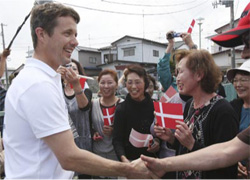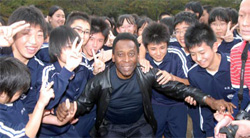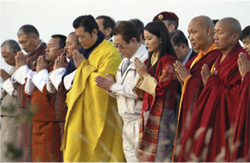Home > Highlighting JAPAN > Highlighting Japan MARCH 2012 > Rising from Adversity—TOHOKU, ONE YEAR ON
Highlighting JAPAN
COVER STORY: Rising from Adversity—TOHOKU, ONE YEAR ON
Rising from Adversity—TOHOKU, ONE YEAR ON

Danish Crown Prince Frederik, left, greets local residents during his visit to the Nobiru area of Higashi-Matsushima in Miyagi Prefecture, June 2011
Credit: AFLO/AP
The gradual process of rebuilding the area affected by the earthquake has been helped along by a great many people pitching in, from all over the world. After the Great East Japan Earthquake struck on March 11, 2011, a worldwide network of support for Japan sprang up in almost no time at all. Japan received messages of sympathy from 254 countries, regions and international organizations during the two months following the quake. Twenty-three countries and regions also sent emergency rescue and medical support teams over to Japan to carry out support activities. Royalty, heads of state and celebrities from all over the world came to visit the affected area too, to provide encouragement to the victims of the earthquake.
Crown Prince Frederik of Denmark was the first overseas royal to visit. In June 2011, he traveled to the city of Higashi-Matsushima in Miyagi Prefecture, where he ate lunch with elementary school students and even enjoyed a game of soccer. He also went on a tour of Matsushima, one of Japan's best-loved beauty spots, on board a cruise ship. The Crown Prince went on to give a donation to Higashi-Matsushima City on behalf of a group of Danish companies. The city used the donation to set up the Denmark Children's Fund, which has been for initiatives to help local children.

Soccer legend Pelé visits a primary school in Natori, Miyagi Prefecture, October 2011
Credit: AFLO/NIKKAN SPORTS
King Jigme Khesar Namgyel Wangchuck of Bhutan and his new queen visited Japan on November 15, just one month after getting married. Bhutan is a country in the Himalayas, on the border between China and India. The king and queen visited Soma in Fukushima Prefecture and met with children from one of the city's elementary schools. They also went to Soma Port, which was damaged by the tsunami, and offered a prayer in memory of those who lost their lives. Seeing the happy couple enthusiastically interacting with people made a real impression on the Japanese public.

King Jigme Khesar Namgyel Wangchuck and Queen Jetsun Peman of Bhutan offer a prayer in Soma, Fukushima Prefecture.
Credit: AFLO/YOMIURI SHIMBUN
"No nation or people should ever have to experience such suffering. And yet if there is one nation who can rise stronger and greater from such adversity—it is Japan and her People."
Encouragement and support from other countries has been widely reported in the Japanese media too, sending out a positive message to people throughout Japan, as well as those affected by the earthquake, and earning the deep gratitude of the entire nation.
Although infrastructures are recovered, there are still many Japanese and foreign victims working hard to put their lives back in order. There are also many Japanese and foreign people supporting these victims. This month's Cover Story features some of the people engaged in such activities in the affected area.
© 2009 Cabinet Office, Government of Japan






